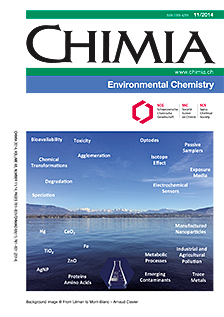Chemical Aspects of Nanoparticle Ecotoxicology
DOI:
https://doi.org/10.2533/chimia.2014.806Keywords:
Agglomeration, Cerium oxide, Exposure media, Nanoparticles, SilverAbstract
Nanoecotoxicology strives to understand the processes and mechanisms by which engineered nanoparticles (ENP) may exert toxic effects on aquatic organisms. Detailed knowledge of the chemical reactions of nanoparticles in the media and of their interactions with organisms is required to understand these effects. The processes of agglomeration of nanoparticles, of dissolution and release of toxic metal ions, and of production of reactive oxygen species (ROS) are considered in this article. Important questions concern the role of uptake of nanoparticles in various organisms, in contrast to uptake of ions released from nanoparticles and to nanoparticle attachment to organism surfaces. These interactions are illustrated for effects of silver nanoparticles (AgNP), cerium oxide (CeO2 NP) and titanium dioxide (TiO2 NP), on aquatic organisms, including algae, biofilms, fish cells and fish embryos.Downloads
Published
2014-11-26
Issue
Section
Scientific Articles
License
Copyright (c) 2014 Swiss Chemical Society

This work is licensed under a Creative Commons Attribution-NonCommercial 4.0 International License.
How to Cite
[1]
L. Sigg, Y. Yue, H. Schug, L. Röhder, F. Piccapietra, N. Odzak, C. Isaacson, K. Groh, R. Behra, K. Schirmer, Chimia 2014, 68, 806, DOI: 10.2533/chimia.2014.806.







